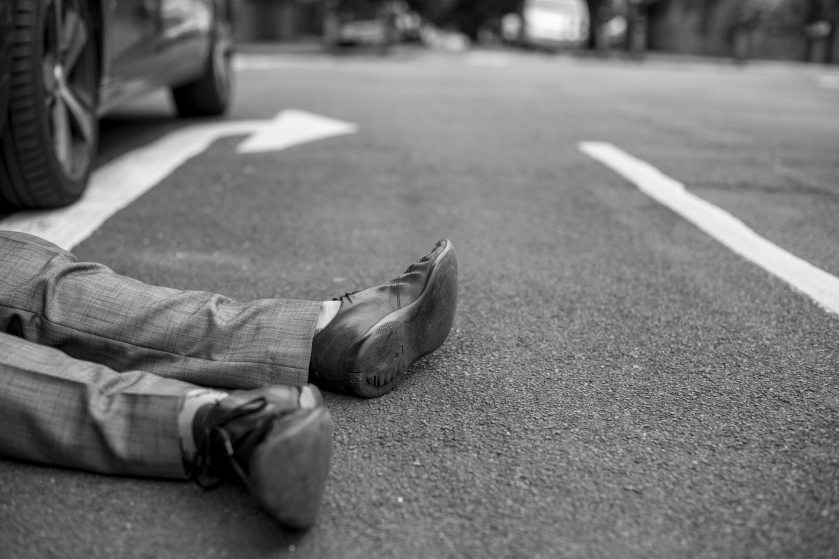
Something rare occurred Thanksgiving morning. I was outside, trying to pry some carrots out of the suddenly frozen dirt of our garden, when it happened.
That section of the yard is slanted, and has always been a treacherous tract for me. Perhaps it was because the ground I was standing on was hard, lumpy, and I couldn’t get a good foothold when I felt my balance shift. Whatever the reason, my bad foot got caught as I was shuffling to my right, my ankle turned, and I was confronted with two choices: stand my ground and risk the full brunt of my weight collapsing on the ankle, which would have resulted a moderate sprain at minimum, or save myself from imminent injury, let gravity do its thing, and let myself fall to the ground. It really wasn’t much of a decision. I stopped resisting and let my body fall.
I wouldn’t say the fall hurt, although it was definitely not a soft landing, and the ground’s rock hard surface did scrape up my right shin a bit. But when my rolling body came to a stop, I reached for my cane, which I relinquished when I stooped over to break up the garden’s surface, clumsily got back onto my feet, and anxiously looked around to see if there were any witnesses. There were none, and I resumed my task. Ten minutes later I was back inside, free from the sub-freezing temps and whipping winds that made the wind chill feel like it was below zero.
The tumble was fairly benign, and the only souvenirs that remain from the episode is a dime-sized scab on my shin and a bruised ego.
Falling is not uncommon for people with MS, and I am no exception. I don’t fall often, averaging perhaps two or three times a year, but it was not always that way. As I rose from the ground and got back onto my feet that freezing Thanksgiving morning, I couldn’t help but reflect that the reason I usually don’t fall very often, or get injured when I do, is because of body awareness and mechanics.
In what seems like a lifetime ago, I joined our college’s Modern Dance Company at the beginning of my freshman year. I had never been involved in this kind of performance art before, but I liked dancing, and I thought it would achieve two important priorities: meeting girls and becoming more flexible. The first priority is self-explanatory, but I had planned on going out for the varsity baseball team later that spring, and I thought being more limber couldn’t hurt.
One thing that my four-year experience with the company taught me was general body awareness: specifically, how it moves, how it is positioned at all times, and where everything is centered. Our company’s director always used to implore that we “find our center” during the first half hour of each class as we stretched, and the lessons learned from those four years have been invaluable to me on the occasions where I do fall.
After the first few tumbles, which were a complete and unexpected surprise that left physical marks, I realized that I needed to become more aware of how my body was centered at all times, which in turn allowed me to apply those lessons. The results were twofold. First, the number of falls dramatically shrank, and when I did fall, I was able to protect myself from serious injury by positioning my body in such a way that I was able to cushion the blow of hitting the ground.
How does it work? I try to be aware of my center, and therefore my balance, whenever I am on my feet. Why? Because if I lose my center, the balance of my weight shifts, which makes my body lean in different directions. When the upper half of my body leans too far forwards, backwards, or to either side, my balance is shot I down I go like a sack of potatoes. Being aware of when I am reaching the point of no return has prevented more falls than I can count, but like last week, they do occasionally occur.
This is where the other part of body mechanic awareness comes in. Before I hit the ground, I try to turn my upper body sideways, exhale, relax the muscles and get into a quasi-fetal position, all within a split second. The goal here is to fall on my side, saving my teeth, facial bones and other joints in the process, in addition to not having the wind knocked out of me when I hit the ground. With the exception of one time many years ago, when I missed the last step on my back stoop with food containers in my hand, I’ve been pretty good at avoiding these kinds of disasters. The back stoop episode occurred during a cookout when my parents were around, and my mother, who had never seen me fall before, nearly freaked when I hit the ground. Nidan, who was maybe ten at the time, thought it was the funniest thing he ever saw, but that is a different story. That particular crash was the only time I can remember where I wound up with impressive bruises and multiple road-burn type abrasions. It could have been much worse.
I’d rather not fall at all, obviously, but they are inevitable, and when they do occur I would much rather have the fleshier body parts absorb the impact. So far, I’ve managed to avoid anything catastrophic, and hope to keep it that way.
Having said that, all bets are off if you lose balance on the stairs. This has been and always will be my biggest fear, because a soft landing is impossible in that scenario, and it is vital that anyone with balance issues be aware of their body mechanics every time you step ono them, especially when you are going down the stairs. Otherwise, the results could be catastrophic.
This doomsday scenario almost happened to me last August, when I was going down the stairs in the grandstand section at Fenway Park. If you know Fenway, there are at least thirty concrete steps that begin at the top of the grandstands and proceed all the way down to the loge box area. Instead of taking the longer route, where I would enter the seating area at the bottom of those steps and go up to my seats, I was lazy and decided to take the much shorter route to my seats. This meant I entered my section of the grandstand from the top of the steps and worked my way down to the seats, which were about fifteen steps down. There are no rails to grab onto for support, and after a couple of steps, my knee locked, my body lurched forward and I felt myself careening forward. I remained upright, but had lost complete control for three or four steps, and understood that in a few seconds a bad scene would unfold.
I remember thinking that this was going to really hurt, that something was going to snap or break, that blood would spill, and I would be humiliated in front of hundreds of people. Fortunately, Zorro, my trusty cane, landed against one of the metal seat legs that was anchored in the concrete. This slowed the momentum to the point where I could grab the top of an empty seat. My hip dug into the corner of that seat with he full weight of my body behind it, which stung like hell, but it stopped the fall, and was infinitely better than hitting those concrete stairs and rolling down God knows how many steps.
My recommendation to those of you who are susceptible to falls is to stay in the moment and be generally aware of your center at all times, which is right around the navel area. If you can keep your weight and balance centered on that point, you won’t fall very often. And if you do, you will be more aware of what is occurring and hopefully be able to position your body so you don’t get hurt when you hit the ground. If you can manage this one time, it will become second nature, and it will go along way in preventing this (or worse):

And please focus on each step whenever you are on the stairs, or avoid them altogether. One of the things I am most looking forward to in the new house is everything is going to be on one floor. That will be one less hazard to deal with.



 The sub-lingual strips, which have a strong peppermint flavor and taste like shit, don’t provide much in the way of relaxation unless you consume the entire square. Since there are only ten strips to each container, that becomes expensive very quickly.
The sub-lingual strips, which have a strong peppermint flavor and taste like shit, don’t provide much in the way of relaxation unless you consume the entire square. Since there are only ten strips to each container, that becomes expensive very quickly.

You must be logged in to post a comment.